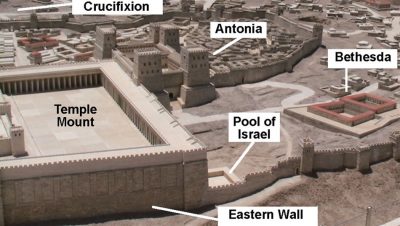“After this there was a festival of the Jews, and Jesus went up to Jerusalem. Now in Jerusalem by the Sheep Gate there is a pool, called in Hebrew[a] Beth-zatha,[b] which has five porticoes. In these lay many invalids—blind, lame, and paralyzed.[c] One man was there who had been ill for thirty-eight years. When Jesus saw him lying there and knew that he had been there a long time, he said to him, “Do you want to be made well?” The sick man answered him, “Sir, I have no one to put me into the pool when the water is stirred up; and while I am making my way, someone else steps down ahead of me.” Jesus said to him, “Stand up, take your mat and walk.” At once the man was made well, and he took up his mat and began to walk. Now that day was a Sabbath.” John 5: 1-9 NRSV
The Gospel of John records a miraculous healing that took place at the Pools of Bethesda. The name of the pools is not mentioned elsewhere in the bible, or in Josephus or other histories. The Hebrew word Beth hesda means “house of mercy” or “house of grace.” In Hebrew and Aramaic it could also mean “shame” or “disgrace.”
The Gospel of John describes the pools as having five porticoes. The pool has an extreme depth of 13 meters. The site was discovered in 1888 by K. Schick. Prior to this scholars did not think the Pools of Bethesda existed. The pool is located below the surface. This is why the site took so long to discover. The pools were originally associated with healing, but recently archeologists discovered the pools were also a mikveh or purification bath.
When the site was first discovered, archeologists only noticed one pool. However, 100 years later when the pool was more carefully evaluated, archeologists discovered that there were two pools. The pools are separated by a wall and this is what gives us the five covered colonnades. This matches the Gospel of John’s description. The lower pool was used as the mikveh while the upper pool was a reservoir that supplied the lower pool with clean water. Some scholars believe that the “upper pool” is mentioned in the Old Testament (for example the book of Isaiah mentions an “upper pool”).
In the first century, Herod Agrippa expanded the city walls that brought the site within the city. When Hadrian rebuilt Jerusalem as Aelia Capitolina, he turned the pools into a large temple to Asclepius. A church was built over the pool in the Byzantine era. This was later destroyed by the Muslims. Afterwards, a church was rebuilt on a smaller scale when the crusaders overthrew the city. The smaller church was built over the wall in the middle of the two pools and a bigger church was built next to it that was dedicated to St. Anne. The Muslims turned the larger church into a religious school. Today it is a major tourist attraction for Christians.

Figure 1: Model of Jerusalem in 70 C.E. (view from Mount of Olives). Two pools make up the Pools of Bethesda. The south and north pools, along with the five colonnaded porches that surround it.
Bibliography
Figure 1: “Pools of Bethesda,” http://www.generationword.com/jerusalem101/51-bethesda-pool.html, accessed May 1, 2014.
“Pool of Bethesda, Just As John Described It,” Thursday, March 7, 2013, http:www.bible-archeology.com/2013/03/pool-of-bethesda-just-as-john-described.html
Wahlde C. Von, Urban. “The Puzzling Pool of Bethesda. Biblical Archeology 65 (2011): 40-47.